According to one of my photo albums, I visited Old Sturbridge Village on September 3, 1989, so my niece suggested that we ought to pay a twenty-year anniversary visit to this outdoor history museum, a re-creation of a rural New England town of the 1830s.
It was an excellent idea: Sturbridge is only a 20-minute drive from my house, and the tropical storm which had brought rain and gloom to the region had passed out to sea overnight. It was sunny and mild, and after a breakfast of waffles and soy sausages, we packed sandwiches and snacks, and then set out to spend almost the entire day visiting these nineteenth-century buildings, talking to the costumed interpreters, watching demonstrations, and trying to imagine what life was like back then.
According to the website, “Old Sturbridge Village’s purpose is to provide modern Americans with a deepened understanding of their own times through a personal encounter with New England’s past.” The Village first opened to the public on June 8, 1946, and in the years since then, millions of visitors have passed through its gates. As an educational institution, the Village does historical research which “includes archaeology, scientific analysis of 19th-century objects and buildings, and painstaking study of letters, diaries, account books, and other documents. ”
We started at the Village Green. Around the Common are the Center Meetinghouse (which today we would call simply the church), the Asa Knight Store, the Parsonage, the Tin Shop, the Grant Store, the Thompson Bank, and individual homes such as the Salem Towne House, the Fitch House, and the Fenno House (all of which we visited).
Farther out from the village center are such buildings as the Freeman Farm and the mills, including the Sawmill, the Grist Mill, and the Carding Mill. (There are quite a few more buildings, but I’m only mentioning the ones we went into.)
At noon, we met the ox team and their drover; shortly thereafter, we witnessed a musket demonstration near the Bullard Tavern. Later in the afternoon, we watched two teams playing tug-of-war on the Common, then at 3 pm, we learned about terpsichorean (dancing) etiquette. Half an hour later, we went back across the covered bridge for demonstrations of the sawmill and the carding machine.
Toward the end of the day, we visited the Print Shop, which I found fascinating, and then just before the exit, we wandered through the Herb Garden, which was almost overwhelming with its profusion of culinary, medicinal, and household plantings.
Here are some random photos I took during the course of the day:
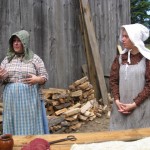
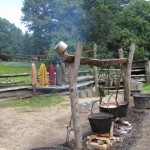
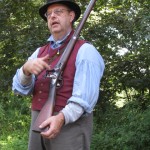
Left: Two interpreters are dressed in women’s costumes typical of this period. Center: Wool is dyed in kettles over open fires. Right: Black powder is used in this musket.
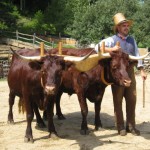
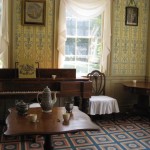
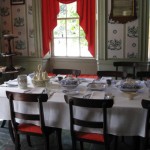
Left: This team of young oxen was taught to plow earlier this spring.
Center: The Towne House furniture and decor are indicative of the family’s wealth.
Right: The Towne House dining room is elegantly appointed.
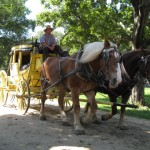
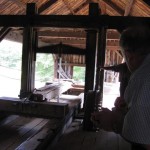
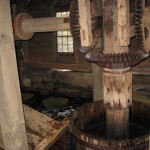
Left: A stagecoach pulled by two horses transports visitors around the grounds.
Center: The sawmill here is cutting boards from logs of white pine.
Right: The carding mill operates by water power; carded wool was for home use.